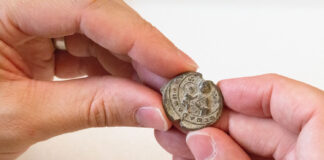Coins represent the most common and widely circulating medium through which Byzantines encountered the image of their emperor. Imperial propaganda and the coinage were closely linked. How the emperors were depicted, what they wore and held, and who was shown alongside them depended on the messages that the imperial regime wished to send out into the empire and the world beyond. Byzantium struck coins for over a millennium and the designs and styles changed with the needs of the empire. Realistic portraiture alternated with stylistic depictions of the ruler, and pagan religious motifs were gradually joined by symbols of Christianity until eventually Christ, the Virgin, and saints came to dominate the coinage, even displacing the imperial image itself. The coins presented in this exhibition thus represent an important part of the story of Byzantium’s imperial and religious history.
In conjunction with a colloquium held in March 1999 to mark the publication of the final two volumes of the Catalogue of the Byzantine Coins in the Dumbarton Oaks Collection and the Whittemore Collection, a special exhibition, Coinage of the Byzantine Empire, was organized at Dumbarton Oaks by Cecile Morrisson, advisor for Byzantine numismatics, and Susan Boyd, curator of the Byzantine collection. They were ably assisted by assistant curator Stephen Zwirn and curatorial assistant Ginger Crockett. Joseph Mills took the photographs that were such an essential part of the exhibit, and the installation was skillfully overseen by Christopher Harrison and Suzanne Mercury.
As a new initiative Dumbarton Oaks has decided to transfer the exhibit to an online format to make it more widely accessible. Clarence Foules, Chris Dunham, and Lauren Henkin of the Publications Department were responsible for the transformation of the exhibit into electronic form.
Coinage of the Byzantine Empire offers insights into the numismatic holdings at Dumbarton Oaks that, with the exception of some spectacular late Roman gold and silver medallions, are only rarely on public display. As is well known, coins are difficult to exhibit because of their small size. A total of 118 gold, silver, and bronze coins were selected for display in three vitrines. They focused, respectively, on three themes: (I) history of the monetary system and its denominations, (II) imperial representations, and (III) religious representations. Photo enlargements and short explanatory comments complemented the coins. Also, seven wall panels of more extensive comparative images, in addition to enlarged photographs of the coins, set the coins in their larger historical context.
The online exhibition can be visited on the website of Dumbarton Oaks.
You can find the online catalogue of Byzantine coins on the Dumbarton Oaks website.
There are also available many other items of the Byzantine culture.




